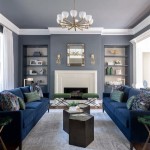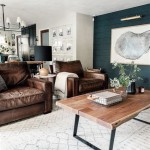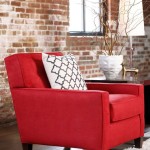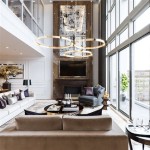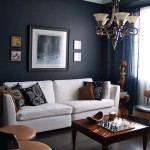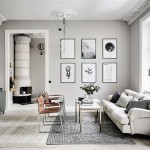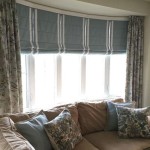Rustic Decorating Ideas For Living Rooms
Rustic decor, characterized by its natural elements, warm tones, and comfortable textures, offers a welcoming and timeless aesthetic for living rooms. It evokes a sense of the outdoors, often incorporating materials like wood, stone, and metal. This style emphasizes simplicity and functionality, prioritizing a relaxed and inviting atmosphere over overt formality. The goal is to create a space that feels both lived-in and stylish, a sanctuary where one can unwind and connect with nature in a subtle yet impactful way.
Achieving a successful rustic look involves careful consideration of color palettes, furniture selection, and accessory choices. It also entails embracing imperfections and celebrating the unique character of natural materials. A key element of rustic decor is its adaptability; it can be seamlessly integrated into various architectural styles, from modern farmhouses to traditional homes. Understanding the core principles of rustic design allows for the creation of a cohesive and personalized living space that reflects individual preferences and complements the existing structure.
Embracing Natural Materials
The cornerstone of rustic decor is the incorporation of natural materials. Wood, in its various forms, is a primary element. This can manifest as exposed wooden beams, reclaimed wood flooring, or furniture crafted from solid wood. The texture and grain of the wood are important; imperfections such as knots and cracks are not only acceptable but also enhance the rustic charm. These details tell a story, adding depth and character to the space. The type of wood used can also influence the overall feel of the room, with darker woods like walnut creating a more formal and traditional rustic look, while lighter woods like pine offer a more casual and contemporary vibe.
Stone is another significant material in rustic design. A stone fireplace is a classic feature, providing both warmth and visual interest. Stone walls, either accent or full, also contribute to the rustic aesthetic, bringing the outdoors inside. The texture of the stone is crucial; rough, uneven stones with natural variations in color create a more authentic rustic feel. Similar to wood, the color of the stone impacts the overall ambiance, with darker stones creating a more dramatic effect and lighter stones contributing to a brighter, airier space.
Metal accents, particularly those with a weathered or aged finish, are also commonly used in rustic decor. Wrought iron chandeliers, metal hardware on furniture, and galvanized steel accents add a touch of industrial charm. The use of copper can also enhance the warmth of the space. The key is to select metals that complement the other natural materials and avoid overly polished or modern finishes. The patina of aged metal adds character and contributes to the overall rustic ambiance.
Beyond these primary materials, other natural elements can be incorporated to further enhance the rustic look. Plants, both living and dried, add a touch of organic beauty. Natural fiber rugs, such as jute or sisal, provide texture and warmth underfoot. Baskets, woven from natural materials, serve as both functional storage and decorative accents. The incorporation of these elements helps to create a cohesive and inviting space that celebrates the beauty of the natural world.
Selecting a Warm and Earthy Color Palette
Color plays a vital role in establishing the rustic aesthetic. A warm and earthy color palette is essential for creating a comfortable and inviting atmosphere. Neutral tones, such as beige, cream, and gray, form the foundation of the palette, providing a calming and versatile backdrop for other colors and textures. These neutral colors reflect natural light and create a sense of spaciousness.
Accent colors, inspired by nature, add depth and visual interest to the space. Warm browns, reminiscent of wood and earth, introduce a sense of comfort and grounding. Greens, inspired by foliage and forests, bring a touch of freshness and vitality. Rusty reds and oranges, evocative of sunsets and autumn leaves, add warmth and drama. The key is to use these accent colors sparingly, allowing the neutral tones to remain dominant.
The intensity of the colors should also be considered. Muted or slightly desaturated shades tend to work best in rustic decor, as they create a more subtle and natural look. Overly bright or vibrant colors can detract from the rustic aesthetic, creating a more modern or contemporary feel. Chalky or matte finishes further enhance the natural and understated quality of the color palette.
Textural elements also contribute to the overall color scheme. Natural materials, such as wood and stone, have inherent colors and variations that should be taken into account when selecting paint colors and other decorative accents. The goal is to create a harmonious and balanced color palette that complements the natural materials and enhances the overall rustic ambiance.
Furniture and Accessory Considerations
Furniture selection is crucial for achieving a successful rustic look. Pieces crafted from solid wood, with a focus on simple lines and sturdy construction, are ideal. Distressed finishes, such as chipped paint or worn edges, add character and authenticity. Upholstered pieces, such as sofas and armchairs, should be comfortable and inviting, with durable fabrics in neutral or earth-toned colors. Leather is a classic choice for rustic decor, adding a touch of luxury and sophistication.
Accessories play a key role in completing the rustic aesthetic. Throw pillows and blankets, made from natural fibers such as wool, cotton, or linen, add warmth and texture to the space. Woven baskets and wooden crates provide functional storage and decorative accents. Candles and lanterns create a warm and inviting ambiance. Antiques and vintage items, such as old maps, antique books, or vintage farmhouse tools, add character and historical interest.
Wall decor should also complement the rustic theme. Framed prints of landscapes or wildlife, vintage signs, and antique mirrors add visual interest. The use of natural materials, such as wood or metal, in picture frames further enhances the rustic aesthetic. Avoid overly modern or abstract artwork, which can clash with the overall style. The key is to select pieces that are both visually appealing and thematically consistent.
Lighting is an important consideration in any living room, and rustic decor is no exception. Warm, ambient lighting is essential for creating a comfortable and inviting atmosphere. Chandeliers with wrought iron details, sconces with exposed bulbs, and table lamps with rustic lampshades all contribute to the rustic aesthetic. Dimmable lights allow for adjustment of the lighting level to suit different moods and activities. The goal is to create a soft, warm glow that enhances the natural materials and textures in the space.
Combining these elements strategically will result in a cohesive and personalized rustic living room. The key is to maintain a balance between natural materials, warm colors, and comfortable furnishings, creating a space that is both visually appealing and functionally inviting. By embracing the simplicity and authenticity of rustic design, one can create a living room that is a true reflection of individual style and a sanctuary for relaxation and connection.

25 Rustic Living Room Ideas Modern Decor And Furniture

41 Best Rustic Living Room Ideas Decor For Rooms

41 Best Rustic Living Room Ideas Decor For Rooms

25 Rustic Living Room Ideas Modern Decor And Furniture

55 Awe Inspiring Rustic Living Room Design Ideas

30 Rustic Living Room Ideas For A Cozy Organic Home Decoist

41 Best Rustic Living Room Ideas Decor For Rooms

25 Rustic Living Room Ideas Modern Decor And Furniture

25 Rustic Living Room Ideas Modern Decor And Furniture

Before After Modern Rustic Living Room Design Online Decorilla

